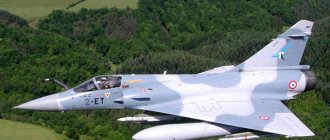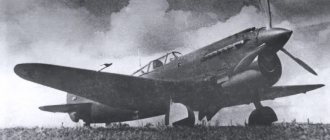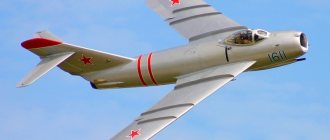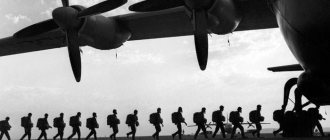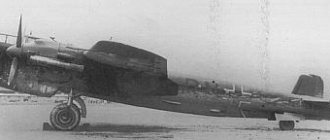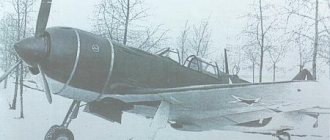On July 29, 1939, a decree was issued on the formation of OKB-135, of which Pavel Osipovich Sukhoi was appointed chief designer. This day is considered the official birthday of the legendary Sukhoi Design Bureau. More than 100 types of aircraft were developed here, almost each of which was a breakthrough in the global aircraft industry. Many models became the founders of aviation generations and the basis for dozens of types of aircraft. Read about the best representatives of each generation in our material.
First generation: number one with the initials "Su"
In 1936, a competition was announced in the country to create a bomber under the code name “Ivanov”. The winner was the project of Pavel Sukhoi. Work on the Ivanov ended with the appearance of the first aircraft with the initials “Su” - the Su-2 combat multi-role bomber (originally BB-1, “short-range bomber”). The aircraft was built in large series from 1940 to 1942, and a total of about 900 aircraft were produced.
Su-2 aircraft
Almost every Sukhoi car can be repaired. The first production aircraft, the Su-2, was no exception and provided military pilots with amazing comfort for those times: a spacious and warm cabin, even in cold weather, with good visibility for the pilot and navigator. A huge advantage in battle was the ability to control the vehicle from the navigator's cockpit.
Su-2 aircraft heroically fought in air battles of the Great Patriotic War and defended the skies of Stalingrad. They were used in the role of short-range bombers, reconnaissance aircraft and spotters. Another important task was solved by the Su-2 crews: we are talking about dropping leaflets in Russian and German over enemy-occupied territory. In just one month, up to 45 thousand leaflets were dropped from airplanes. They instilled hope in millions of people in occupied cities, talking about the great losses of fascist troops and reporting the beginning of Allied air raids on German cities.
Military designer
Among other aircraft designers, Sukhoi is primarily known for its military developments. But the specialization is justified - the inventor headed the group in 1930, and at that time the country had reason to fear war.
Under the wing of Tupolev
Before the war, while working at the Tupolev Design Bureau, P.O. Sukhoi made a significant contribution to the creation of the I-4 and I-14 aircraft. He also worked on the ANT-25 project, known as RD (Range Record). This record of flight across the North Pole of the Earth was achieved by crews led by Chkalov and Gromov.
The designer also worked on the DB-2 bomber, on a modification of which, known as “Rodina,” Grizodubov and his team set their record.
In 1939, the group was separated into a separate organization, and the official history of the Sukhoi Design Bureau dates back to 1940. But he had the opportunity to work again under the leadership of Tupolev. In the post-war years, the design bureau was disbanded after a number of failures, and Pavel Osipovich worked as chief designer at the Tupolev Design Bureau in 1949-1953.
Second generation: the beginning of the jet fighter era
In 1949, the Sukhoi design bureau was disbanded, but in May 1953 it was restored again. The revival of the design bureau coincided with the advent of supersonic jet aircraft and the development of a second-generation fighter.
The government instructed the Sukhoi Design Bureau to create two types of fighters: front-line and interceptor. The OKB team begins work on two options at once, assigning codes to the products: T - delta wing, S - swept wing. Thus, the main directions in the work of the design bureau for the next ten years were supersonic fighters S-1 and T-3.
The first flight of the S-1 front-line fighter took place in September 1955. Three years later it was put into production under the designation Su-7. This jet fighter became the first successful aircraft of the revived Sukhoi Design Bureau.
Su-7 aircraft
For a new generation aircraft capable of twice the speed of sound, Pavel Sukhoi chose the AL-7F engine, which was still being designed, designed by Arkhip Lyulka. For decades, these two legendary designers will work together.
Simultaneously with the creation of the S-1 (in the series - Su-7) with a swept wing, the Sukhoi Design Bureau was working on an aircraft with a delta wing - T-3 (in the series - Su-9). This interceptor was capable of destroying enemy air targets thanks to one of the first domestic radar stations installed on board - RP-9 (TsD-30).
Su-7 aircraft have become long-lived combat aircraft. They were in service with nine countries of the world, in addition to the USSR, for 40 years. More than 10 modifications have been developed based on the Su-7, including experimental aircraft and flying laboratories. One of them is the S-22I aircraft, which became the founder of a new family of aircraft such as the Su-17. Developed in the mid-1960s, it became the first domestic aircraft with a variable-sweep wing. The Su-9 interceptor was in service for about 20 years and became the basis for a family of aircraft: Su-11, Su-15, Su-17.
Su-9 aircraft
The Su-15 was equipped with a radar station with a large diameter antenna in the forward fuselage, which provided a significant increase in combat performance. The aircraft was capable of intercepting on a collision course and intercepting low-altitude targets.
Stormy youth
Pavel Osipovich was born on July 10 (22), 1895 in the village. Glubokoe, Disnensky district, Vilna province (now Glubokoe town, Vitebsk region, Belarus) in the family of a primary school teacher in a rural school. In addition to him, five more girls were raised in a large family.
The village teacher Osip Andreevich Sukhoi did not suspect that his newborn son Pavel was destined to glorify his family name. The father of the family was glad that he now had an heir and planned how he would educate his son.
He did everything possible to ensure that his children developed diversified, which is why the family had a huge library, thanks to which Pavel and his sisters received their knowledge. They also enjoyed reading, music, playing the violin and choral singing.
It is thanks to the fact that Osip Andreevich paid great attention to the education and development of his children that his son Pavel in the future will become a world-famous aircraft designer.
After the family moved to Gomel, where Osip Andreevich was offered to head the school, Pavel entered the local boys' gymnasium (now the old BelGut building), where he studied from 1905-1914. It was here that his excellent abilities in such sciences as mathematics, physics, and technology manifested themselves.
Ah, the desperate pilot Utochkin...
The biography of aircraft designer and inventor Pavel Sukhoi is eventful. But a minor episode decided his fate.
While still a high school student, Pavel, returning home with the boys after lessons, watched the flight of the famous Sergei Utochkin on an airplane; the guys were breathtaking from what they saw.
The impression made by this spectacle served as the basis for his professional choice. After graduating from high school, in 1914 the persistent student was lucky enough to become a volunteer student at the Faculty of Physics and Mathematics of Moscow State University and attend lectures “on flight mechanics” by Zhukovsky himself.
Then in 1915, Pavel entered the Moscow Imperial Higher Technical School. At that time, only there it was possible to join aviation.
I managed to get in on the second try, because... in 1914, he was denied admission due to the fact that documents were submitted incorrectly to the Admissions Committee of the IVTU (copies were submitted instead of originals).
On the fronts of the First World War
I didn’t have the chance to graduate from college - the First World War got in the way. Pavel Osipovich was called up for military service in the Russian army, first he was trained at the school of warrant officers, after which he was sent to the Western Front, where he served in the artillery.
He began his service with the rank of ensign and ended in March 1918 with the rank of staff captain.
At that time, he was the head of the regiment's machine gun team and had about 100 subordinates. Military experience helped the future designer learn to lead. The skills were useful when organizing a design bureau.
Finding yourself
Being an officer in the tsarist army in revolutionary Russia was inconvenient—they were wary of them. Therefore, in 1918-1920, P.O. Sukhoi held a modest position as a mathematics teacher at school (in Luninets, then in Gomel).
But the degree of distrust of the revolutionary authorities towards officers is now tended to be exaggerated. Many of them managed to adapt to the new conditions, and the young staff captain was among them.
In 1920 he returned to technical school, combining study with work. Having completed his studies in 1925, he received the position of design engineer at AGOS (department of aviation, hydroaviation and experimental construction). This department became the basis of the Tupolev Design Bureau. Soon Pavel Osipovich headed a separate group.
Third generation: all-weather Su-24
The third generation is represented by the Su-24, an all-weather front-line bomber with a variable-sweep wing. This aircraft is still successfully operated by the Russian Aerospace Forces 26 years after its production ended.
Designers of the Sukhoi Design Bureau have created a powerful twin-engine supersonic missile-carrying bomber with a variable-sweep wing. On board the aircraft was the latest sighting and navigation system for that time, “Puma,” which included an on-board digital computer (onboard digital computer). A distinctive feature of the vehicle was also a wide range of weapons, which included both guided and unguided weapons. The Su-24 became the first tactical aviation strike aircraft in the USSR, which could be used at any time of the day or night and in any weather conditions.
Su-24 aircraft
In 1983, the modernized Su-24M was put into service. By the way, almost half of the combat missions were carried out on this vehicle during the Russian military operation in Syria.
Student of Tupolev
In 1920, the Council of People's Commissars issued a resolution on the return of students to universities. A Technical School was also opened in Moscow. In 1921, 26-year-old Pavel Sukhoi went to Moscow to continue his studies, which had been interrupted for six years.
He not only studied, but also worked in the evenings at Nikolai Fomin’s design bureau, where airships were designed. Sukhoi needed money - in 1923 he married his fellow countrywoman, a teacher, whom he met in Western Belarus.
Even before graduating from college, in 1924, Pavel Sukhoi began working as a draftsman in the experimental department of the Central Aerohydrodynamic Institute.
The time had come for the graduation project, and aircraft designer Andrei Tupolev .
Tupolev recognized great talent in the far from young student. The thesis “Single-seat fighter with a 300 horsepower engine” was successfully defended, and 30-year-old Pavel Sukhoi received the qualification “mechanical engineer”, and with it an offer from Tupolev to continue working together in the design department of TsAGI. Sukhoi was included in the design team of A. N. Putilov as a design engineer.
Fourth generation: Su-27 aerobatics master
The highly maneuverable Su-27 fighter, which first took off in 1977, is rightfully recognized as one of the best domestic combat aircraft. This fourth generation fighter has become the hallmark of the Russian Air Force.
The Su-27 was officially accepted into service on August 23, 1990. By that time, the “twenty-seventh” had already managed to set a number of world records for rate of climb. In particular, in 1986, test pilot Viktor Pugachev reached an altitude of 3000 meters in just 25.4 seconds.
Literally three years later, Viktor Pugachev again surprised the whole world. In June 1989, at the Le Bourget air show, he staged the most spectacular foreign premiere of the Su-27, demonstrating a new aerobatics maneuver, which was nicknamed in his honor - “Pugachev’s Cobra.” Aerobatics performed on the Su-27 continue to amaze spectators at prestigious air shows around the world. Since 1991, pilots of the Russian Air Force aerobatic team “Russian Knights” have performed on Su-27 fighters.
Su-27 aircraft
The high maneuverability of the Su-27 was made possible thanks, among other things, to the new fly-by-wire control system (EDCS). Its presence, by the way, is considered one of the main differences between fourth-generation machines.
The high flight characteristics of the “twenty-seventh” are largely due to the use of new generation AL-31F engines designed by the Design Bureau named after. Cradles. This engine is still considered one of the best in the world for front-line aircraft. It is installed not only on the Su-27, but also on its modifications, Su-33 carrier-based fighters, Su-30MK fighters, and Su-34 front-line bombers.
In memory of the designer
The homeland valued the inventor’s achievements during his life and after his death. He was awarded three Orders of Lenin, the Order of the October Revolution, the Red Banner of Labor, the Red Star, the Badge of Honor, and the Star of the Hero of Socialist Labor (twice). He was also awarded the State and Lenin Prizes.
Nowadays they bear his name:
- streets in Moscow, Gomel, Vitebsk;
- school in the city of Glubokoe (the birthplace of the designer);
- Gomel State Technical University.
And in many countries, Su aircraft stand on pedestals - monuments both to the designer and to those who managed to use his achievements with dignity.
Pavel Osipovich Sukhoi is a whole era in the creation of fighters, fighter-interceptors, bombers, as well as civil aircraft.
But he remained in people’s memory not only as the outstanding founder of Soviet jet and supersonic aviation, but also as a noble man. He was always precise, polite and valued discipline.
One step away from the fifth generation: young heirs of the Su-27
Since 1984, when serial production of the “twenty-seventh” began, about 1,500 aircraft of this type, including its modifications, have been produced. On its basis, such machines as the multifunctional two-seat fighter Su-30MK, the ship-based Su-33 aircraft, the two-seat attack aircraft Su-34, and the multifunctional single-seat fighter Su-35S were created.
These machines are one step away from the fifth generation of fighters and belong to the so-called “4+” generation. First of all, this is a breakthrough in the field of super-maneuverability. It began in the mid-1990s, when dryers began to be equipped with engines with thrust vector control. New engines, combined with a new control system, have significantly simplified the aircraft's piloting and increased its safety. The problems of “spin” and stalling were overcome.
Su-30SM aircraft
The multirole fighter Su-30MK fully possesses these qualities. The aircraft was originally designed for the Indian Air Force; mass production of these aircraft began in 2000. Based on the basic version, several new modifications were created: Su-30MKM for the Malaysian Air Force, Su-30MKI(A) for the Algerian Air Force. The Su-30SM (serial, modernized) is currently being actively supplied to the Russian Aerospace Forces. In 2016, the Russian Knights switched to these fighters.
The youngest successors of the Su-27 - the multirole fighter Su-35 and the fighter-bomber Su-34 - in their characteristics practically correspond to the fifth generation of aviation. The Su-35 is equipped with the latest Irbis radar and AL-41F1S engines, which are more powerful than those on the Su-30SM.
The Su-34 bomber can attack targets in any weather conditions, and also effectively conduct electronic warfare. These machines are distinguished by a cockpit that is unusual for a dryer. To increase crew comfort during long-distance flights, it was decided to seat the pilots nearby.
Fifth generation: the future of Su-57 combat aviation
The main difference of the fifth generation is the use of stealth technology, supersonic cruising speed, and more advanced avionics.
The first tests of the Russian advanced front-line aviation complex (PAK FA) began in 2010. Until August 2022, the aircraft was known under the factory designation T-50, then it received the name Su-57.
Most of the characteristics of the Su-57 are classified, but it is already known that it is equipped with a fundamentally new set of integrated avionics that provides intelligent support for the crew. The radar system of the Su-57 differs from a conventional aircraft airborne radar. The fighter is equipped with a radar station with AFAR (active phased array antenna).
Su-57 aircraft
The first flight of the Russian fifth-generation fighter took place on January 29, 2010. Since then, several hundred test flights have been successfully carried out. To date, ten flight prototypes have been created.
In 2022, a contract was signed with the Russian Ministry of Defense for the supply of an initial batch of Su-57 aircraft to the troops. And in May of this year, Vladimir Putin announced the purchase by the Ministry of Defense of 76 Su-57 fighters, which should enter service with three aviation regiments by 2028. This contract may become a record in the history of the United Aircraft Corporation (UAC).
